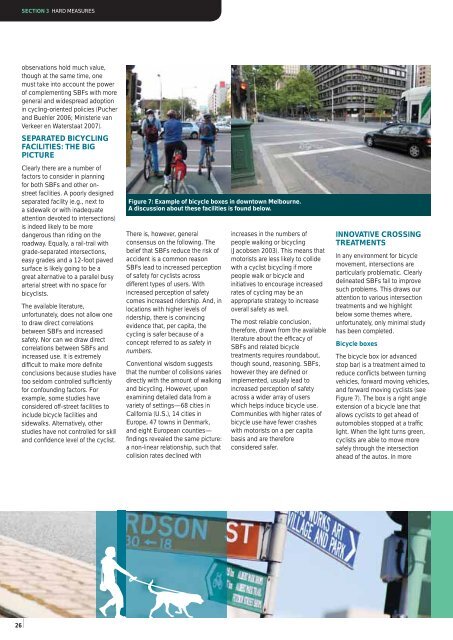Walking and Cycling International Literature Review - Department of ...
Walking and Cycling International Literature Review - Department of ...
Walking and Cycling International Literature Review - Department of ...
Create successful ePaper yourself
Turn your PDF publications into a flip-book with our unique Google optimized e-Paper software.
SECTION 3 HARD MEASURES<br />
observations hold much value,<br />
though at the same time, one<br />
must take into account the power<br />
<strong>of</strong> complementing SBFs with more<br />
general <strong>and</strong> widespread adoption<br />
in cycling-oriented policies (Pucher<br />
<strong>and</strong> Buehler 2006; Ministerie van<br />
Verkeer en Waterstaat 2007).<br />
SEPARATED BICYCLING<br />
FACILITIES: THE BIG<br />
PICTURE<br />
Clearly there are a number <strong>of</strong><br />
factors to consider in planning<br />
for both SBFs <strong>and</strong> other onstreet<br />
facilities. A poorly designed<br />
separated facility (e.g., next to<br />
a sidewalk or with inadequate<br />
attention devoted to intersections)<br />
is indeed likely to be more<br />
dangerous than riding on the<br />
roadway. Equally, a rail-trail with<br />
grade-separated intersections,<br />
easy grades <strong>and</strong> a 12-foot paved<br />
surface is likely going to be a<br />
great alternative to a parallel busy<br />
arterial street with no space for<br />
bicyclists.<br />
The available literature,<br />
unfortunately, does not allow one<br />
to draw direct correlations<br />
between SBFs <strong>and</strong> increased<br />
safety. Nor can we draw direct<br />
correlations between SBFs <strong>and</strong><br />
increased use. It is extremely<br />
diffi cult to make more defi nite<br />
conclusions because studies have<br />
too seldom controlled suffi ciently<br />
for confounding factors. For<br />
example, some studies have<br />
considered <strong>of</strong>f-street facilities to<br />
include bicycle facilities <strong>and</strong><br />
sidewalks. Alternatively, other<br />
studies have not controlled for skill<br />
<strong>and</strong> confi dence level <strong>of</strong> the cyclist.<br />
Figure 7: Example <strong>of</strong> bicycle boxes in downtown Melbourne.<br />
A discussion about these facilities is found below.<br />
There is, however, general<br />
consensus on the following. The<br />
belief that SBFs reduce the risk <strong>of</strong><br />
accident is a common reason<br />
SBFs lead to increased perception<br />
<strong>of</strong> safety for cyclists across<br />
different types <strong>of</strong> users. With<br />
increased perception <strong>of</strong> safety<br />
comes increased ridership. And, in<br />
locations with higher levels <strong>of</strong><br />
ridership, there is convincing<br />
evidence that, per capita, the<br />
cycling is safer because <strong>of</strong> a<br />
concept referred to as safety in<br />
numbers.<br />
Conventional wisdom suggests<br />
that the number <strong>of</strong> collisions varies<br />
directly with the amount <strong>of</strong> walking<br />
<strong>and</strong> bicycling. However, upon<br />
examining detailed data from a<br />
variety <strong>of</strong> settings—68 cities in<br />
California (U.S.), 14 cities in<br />
Europe, 47 towns in Denmark,<br />
<strong>and</strong> eight European counties—<br />
fi ndings revealed the same picture:<br />
a non-linear relationship, such that<br />
collision rates declined with<br />
increases in the numbers <strong>of</strong><br />
people walking or bicycling<br />
(Jacobsen 2003). This means that<br />
motorists are less likely to collide<br />
with a cyclist bicycling if more<br />
people walk or bicycle <strong>and</strong><br />
initiatives to encourage increased<br />
rates <strong>of</strong> cycling may be an<br />
appropriate strategy to increase<br />
overall safety as well.<br />
The most reliable conclusion,<br />
therefore, drawn from the available<br />
literature about the effi cacy <strong>of</strong><br />
SBFs <strong>and</strong> related bicycle<br />
treatments requires roundabout,<br />
though sound, reasoning. SBFs,<br />
however they are defi ned or<br />
implemented, usually lead to<br />
increased perception <strong>of</strong> safety<br />
across a wider array <strong>of</strong> users<br />
which helps induce bicycle use.<br />
Communities with higher rates <strong>of</strong><br />
bicycle use have fewer crashes<br />
with motorists on a per capita<br />
basis <strong>and</strong> are therefore<br />
considered safer.<br />
INNOVATIVE CROSSING<br />
TREATMENTS<br />
In any environment for bicycle<br />
movement, intersections are<br />
particularly problematic. Clearly<br />
delineated SBFs fail to improve<br />
such problems. This draws our<br />
attention to various intersection<br />
treatments <strong>and</strong> we highlight<br />
below some themes where,<br />
unfortunately, only minimal study<br />
has been completed.<br />
Bicycle boxes<br />
The bicycle box (or advanced<br />
stop bar) is a treatment aimed to<br />
reduce confl icts between turning<br />
vehicles, forward moving vehicles,<br />
<strong>and</strong> forward moving cyclists (see<br />
Figure 7). The box is a right angle<br />
extension <strong>of</strong> a bicycle lane that<br />
allows cyclists to get ahead <strong>of</strong><br />
automobiles stopped at a traffi c<br />
light. When the light turns green,<br />
cyclists are able to move more<br />
safely through the intersection<br />
ahead <strong>of</strong> the autos. In more<br />
26

















